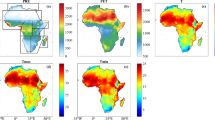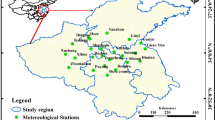Abstract
Predicting natural phenomena like flood and drought and consequently presenting an appropriate solution for fighting such natural hazards in northwestern Iran is considered in this study through clustering the precipitation regime. To compare the reference period (past) with the simulated data, the statistics of daily precipitation in six stations of Ardebil, Ghazvin, Hamedan, Kermanshah, Sanandaj, and Tabriz, have been provided for a 30-year period (1961–1990) and compared with the simulated data of 2021–2050. The simulated data was generated by general atmosphere circulation model HADCM3, A1scenario and was downscaled using the LARS-WG model. The method for comparing precipitations was done based on clustering in the form of 5 clusters for all the stations and study periods. One of the results of this research is the greater concentration of precipitation for the cold periods of the year (winter and fall) and the increase of annual precipitation by the amount of 20.62 mm for future period. Furthermore, the normality of two coordinates of precipitation and cluster frequency percentage was evaluated. The outputs of this section demonstrate that the precipitations of cluster 3 which have the features of light rain with average intensity, fall on this normal line for most of the stations and study periods. On the other hand, precipitations of cluster 1 indicating very heavy and intense precipitations, have the most distance to the normal line in most cases. Therefore, the precipitations of the third cluster need optimal exploitation management while those of the first cluster need required risk and crisis management.






Similar content being viewed by others
References
Babaeian I, Kwon WT (2005) Climate change assessment over Korea using stochastic daily data. Proceeding of the First Iran–Korea Joint Workshop on Climate Modeling, Nov. 2005. Climate Research Institute, Mashad
Babaeian I, Najafi Nik Z (2006) The introduction and evaluation of the LARS model for modeling the meteorological parameters of Khorasan Province in the period 1961–2003. J Nivar 62:49–65, In Persian
Bazrafshan J, Khalili A, Hoorfar A, Torabi S, Hajjaj L (2009) Assessment and comparison of the function of the LARS model and the ClimGen model in simulating the variables of meteorology in different climatic conditions of Iran. J Res Iran Water Resour 1:44–57, In Persian
Belmar O, Velasco J, Martínez-Capel F, Peredo-Parada M, Snelder T (2012) Do environmental stream classifications support flow assessments in Mediterranean basins? Water Resour Manag 26:3803–3817
Cancelliere A, Di Mauro G, Bonaccorso B, Rossi G (2007) Drought forecasting using the standardized precipitation index. Water Resour Manag 21:801–819
Chaudhari QZ (1994) Pakistan’s summer monsoon rainfall associated with global and regional circulation features and its seasonal prediction. Proceedings of the International Conference on Monsoon Variability and Prediction, May 9–13, Trieste, Italy
Dore MHI (2005) Climate change and changes in global precipitation patterns: what do we know? Environ Int 31:1167–1181
Georgakakos KP, Bae D, Jeong C (2005) Utility of ten-day climate model ensemble simulations for water resources applications in Korean watersheds. Water Resour Manag 19:849–872
Ghosh S, Katkar S (2012) Modeling uncertainty resulting from multiple downscaling methods in assessing hydrological impacts of climate change. Water Resour Manag 26:3559–3579
Hulme M, Osborn TJ, Johns TC (1998) Precipitation sensitivity to global warming: comparison of observations with HadCM2 simulations. Geophys Res Lett 25:3379–3382
Johnson GL, Hanson CL, Hardegree SP, Ballard EB (1996) Stochastic weather simulation: overview and analysis of two commonly used models. J Appl Meteorol 35:1878–1896
Karamouz M, Imen S, Nazif S (2012) Development of a demand driven hydro-climatic model for drought planning. Water Resour Manag 26:329–357
Lawless C, Semenov MA (2005) Assessing lead-time for predicting wheat growth using a crop simulation model. Agr Forest Meteorol 135:302–313
MacDonald RJ, Byrne JM, Boon S, Kienzle SW (2012) Modelling the potential impacts of climate change on snowpack in the North Saskatchewan River Watershed, Alberta. Water Resour Manag 26:3053–3076
Qian BD, Gameda S, Hayhoe H, De Jong R, Bootsma A (2004) Comparison of LARSWG and AAFC-WG stochastic weather generators for diverse Canadian climates. Climate Res 26:175–191
Roshan GHR, Grab SW (2012) Regional climate change scenarios and their impacts on water requirements for wheat production in Iran. Int J Plant Prod 2:239–265
Roshan GHR, Khoshakhlagh F, Karampur M (2012) Assessing, modifying and synthesizing a suitable model for estimation of potential evapotranspiration in Iran. Phys Georg Geography Res 78:49–68 (In Persian)
Sajjad Khan M, Coulibaly P, Dibike Y (2006) Uncertainty analysis of statistical downscaling methods. J Hydrol 319:357–382
Semenov MA (2007) Developing of high-resolution UKCUP02-based climate change scenarios in the UK. Agr Forest Meteorol 144:127–138. doi:10.1016/j.agrformet.2006.01.002
Semenov MA, Barrow EM (1997) Use of a stochastic weather generator in the development of climate change scenarios. Clim Chang 35:397–414
Semenov MA, Barrow EM (2002) LARS-WG a stochastic weather generator for use in climate impact studies. User’s manual, Version3.0. http://www.rothamsted.ac.uk/mas-models/download/LARS-WG-Manual.pdf
Semenov MA, Brooks RJ, Barrow EM, Richardson CW (1998) Comparison of the WGEN and LARS-WG stochastic weather generators in diverse climates. Clim Res 10:95–107
Tisseuil C, Roshan GR, Nasrabadi T, Asadpour GA (2013) Statistical modeling of future lake level under climatic conditions, case study of Urmia Lake (Iran). Int J Environ Res 7(1):69–80
Xu YP, Zhang X, Tian Y (2012) Impact of climate change on 24-h design rainfall depth estimation in Qiantang River Basin, East China. Hydrol Process. doi:10.1002/hyp.9210
Zarghami M, Abdi A, Babaeian I, Hassanzadeh Y, Kanani R (2011) Impacts of climate change on runoffs in East Azerbaijan, Iran. Glob Planet Chang 78:137–146
Zhao L, Xia J, Sobkowiak L, Wang Z, Guo F (2012) Spatial pattern characterization and multivariate hydrological frequency analysis of extreme precipitation in the Pearl River Basin, China. Water Resour Manag 26:3619–3637
Zhi W, Shirong L, Liandi Z, Zhihua G, Pengsen S, Hong L (2011) The relationship of vegetation greenness period and climate precipitation change in the North–south transect of Eastern China. Procedia Environ Sci 10(Part A):282–288
Acknowledgments
The authors are grateful for the help of Dr. M.S. Najafi from the Department of Geography, Tabriz University, in obtaining the data and kindly appreciate this favor. Furthermore, we express special thanks to Professor Yue-Ping Xu, Institute of Hydrology and Water Resources, Civil Engineering, Zhejiang University for his invaluable pieces of advice.
Author information
Authors and Affiliations
Corresponding author
Rights and permissions
About this article
Cite this article
Roshan, G., Ghanghermeh, A., Nasrabadi, T. et al. Effect of Global Warming on Intensity and Frequency Curves of Precipitation, Case Study of Northwestern Iran. Water Resour Manage 27, 1563–1579 (2013). https://doi.org/10.1007/s11269-013-0258-7
Received:
Accepted:
Published:
Issue Date:
DOI: https://doi.org/10.1007/s11269-013-0258-7




